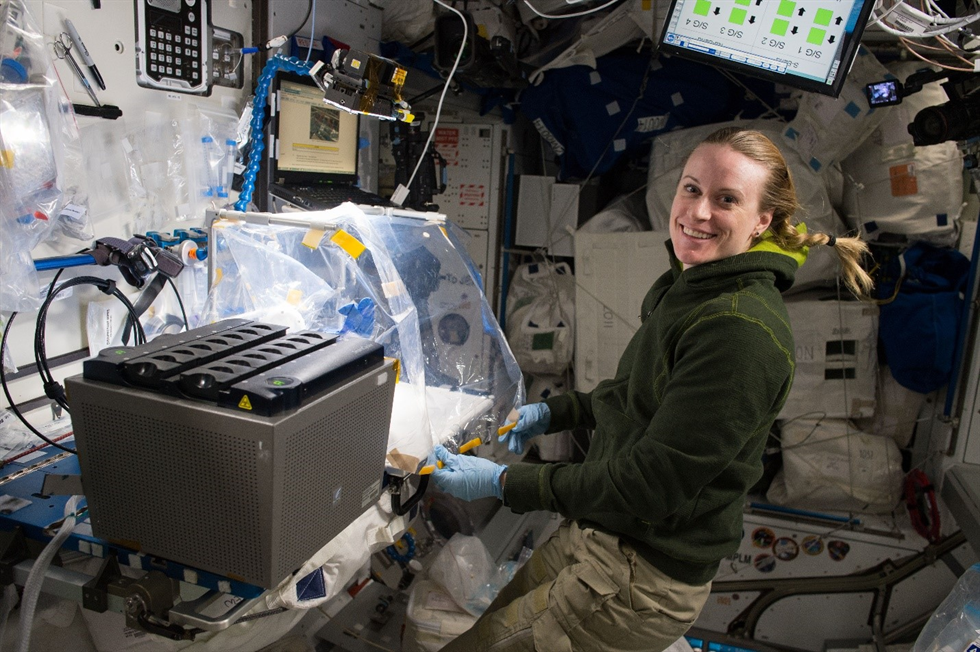Back to (nucleic) bases
2018-04-25
Johnson Space Center celebrates National DNA Day with genomics research
April 25 is National DNA Day, and this year NASA’s Johnson Space Center is celebrating by remembering recent advancements in genomics research capability for the International Space Station.
Since the first in-orbit sequencing of DNA by NASA astronaut Kate Rubins in 2016, the space station has hosted an increasing range of genetic investigations made possible by an advanced suite of tabletop and palm-sized tools, including MinION, miniPCR and Wet-Lab-2, with more tools and processes on the horizon.
This year, those testing capabilities translated into an even stronger portfolio of DNA-focused research for the space station. For example, miniPCR is being used to test weakened immune systems and DNA alterations as part of a student-designed investigation known as Genes in Space-5.
Coordinated and supported by the Johnson’s International Space Station Program Science Office, this fast-paced science schedule includes commercial, government and academic research and technology demonstrations.
“The mini revolution has begun. These are very small, efficient tools. We have a nicely equipped molecular lab on station and devices ideally sized for spaceflight,” said Sarah Wallace, NASA’s principal investigator for the upcoming Biomolecule Extraction and Sequencing Technology (BEST) investigation. BEST is scheduled to launch to the station later this spring and will compare swab-to-sequencer testing of unknown microbes aboard the space station against current culture-based methods.
“We see changes in gene expression in response to spaceflight for every living thing in which we have looked for it,” Wallace said. “Studying those changes is critical to understand adaptations to spaceflight and also provides the potential to discover novel responses that could result in alternative healthcare treatments on Earth.”
While resupply and ground support are available for astronauts aboard the space station, missions beyond low-Earth orbit will require crews to rely on these new, space-saving technologies to track their health across time and to monitor potential health risks living alongside them. Fast, reliable sequencing and identification processes could keep explorers safer on missions into deep space. On Earth, these technologies may make genetic research more accessible, affordable and mobile.
To learn more about the science happening aboard the space station, follow @ISS_Research for daily updates. For opportunities to see the space station pass over your town, check out Spot the Station.

NASA astronaut Kate Rubins works with Wet Lab-2, a tool for quantitative gene expression analysis set for further testing this year. Image Credit: NASA
Morgan McAllister
NASA Johnson Space Center
April 25 is National DNA Day, and this year NASA’s Johnson Space Center is celebrating by remembering recent advancements in genomics research capability for the International Space Station.
Since the first in-orbit sequencing of DNA by NASA astronaut Kate Rubins in 2016, the space station has hosted an increasing range of genetic investigations made possible by an advanced suite of tabletop and palm-sized tools, including MinION, miniPCR and Wet-Lab-2, with more tools and processes on the horizon.
This year, those testing capabilities translated into an even stronger portfolio of DNA-focused research for the space station. For example, miniPCR is being used to test weakened immune systems and DNA alterations as part of a student-designed investigation known as Genes in Space-5.
Coordinated and supported by the Johnson’s International Space Station Program Science Office, this fast-paced science schedule includes commercial, government and academic research and technology demonstrations.
“The mini revolution has begun. These are very small, efficient tools. We have a nicely equipped molecular lab on station and devices ideally sized for spaceflight,” said Sarah Wallace, NASA’s principal investigator for the upcoming Biomolecule Extraction and Sequencing Technology (BEST) investigation. BEST is scheduled to launch to the station later this spring and will compare swab-to-sequencer testing of unknown microbes aboard the space station against current culture-based methods.
“We see changes in gene expression in response to spaceflight for every living thing in which we have looked for it,” Wallace said. “Studying those changes is critical to understand adaptations to spaceflight and also provides the potential to discover novel responses that could result in alternative healthcare treatments on Earth.”
While resupply and ground support are available for astronauts aboard the space station, missions beyond low-Earth orbit will require crews to rely on these new, space-saving technologies to track their health across time and to monitor potential health risks living alongside them. Fast, reliable sequencing and identification processes could keep explorers safer on missions into deep space. On Earth, these technologies may make genetic research more accessible, affordable and mobile.
To learn more about the science happening aboard the space station, follow @ISS_Research for daily updates. For opportunities to see the space station pass over your town, check out Spot the Station.

NASA astronaut Kate Rubins works with Wet Lab-2, a tool for quantitative gene expression analysis set for further testing this year. Image Credit: NASA
Morgan McAllister
NASA Johnson Space Center

The miniPCR is used for a variety of genetic investigations to help astronauts quickly amplify—or make copies of—a single DNA sequence. Image Credit: NASA

NASA astronaut Ricky Arnold prepares the miniPCR for Genes in Space-5, a student designed investigation studying alterations in DNA that may lead to weakened immunity. Image Credit: NASA







